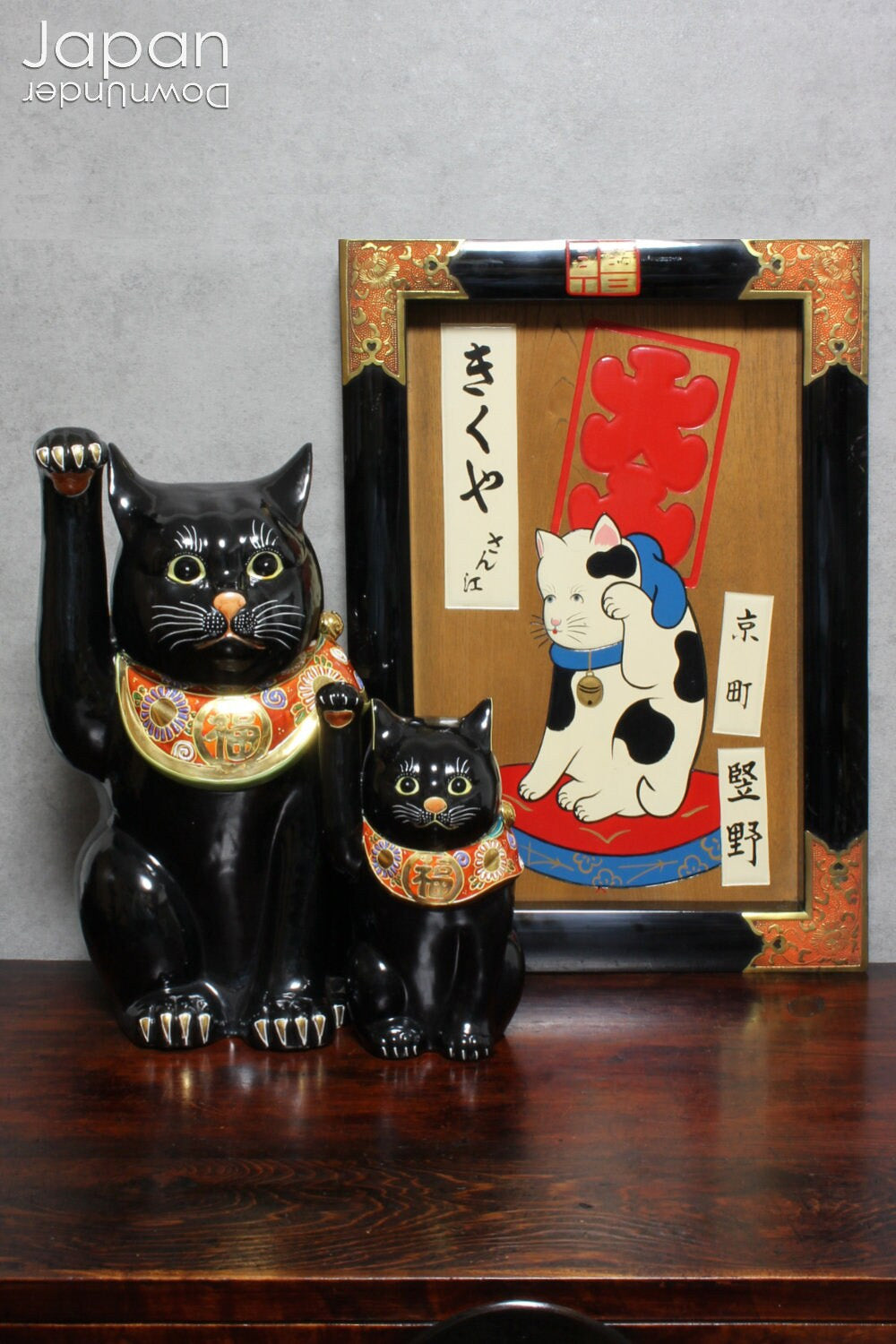My Store
large japanese vintage ceramic kutani maneki neko - black cat decor
large japanese vintage ceramic kutani maneki neko - black cat decor
Couldn't load pickup availability
Love Japanese Style Like We Do
Bring an aura of opulence and good fortune into your space with this exceptional large and weighty black Kutani Maneki Neko cat. Radiating simple elegance with a bold presence, this stunning piece beckons wealth and happiness while making a refined decorative statement. It's a must-have for anyone seeking to infuse their home or business with a touch of charm and auspicious energy.
Standing an impressive 38 cm (15") tall, this captivating cat is entirely black - symbolic of protection and mystery - with a striking contrast in its ornate orange bib. Tied neatly at the back, the bib is adorned with shimmering green and gold bamboo leaves, and two gold bells dangle from its collar, catching the light and the eye. The surface of the bib is richly textured in the traditional Mori style, featuring raised patterns of chrysanthemums, swirling motifs, and a circle framing the Japanese kanji 福 (fuku) - representing good luck.
The cat's expression is irresistibly endearing, with large, round eyes full of life, delicately sculpted dimensional whiskers and eyebrows, and a sweet pink nose and mouth. Its gold-tipped claws are highlighted with raised white lines that create a three-dimensional shadow effect, enhancing the lifelike detail.
Every element of this Maneki Neko is steeped in symbolism:
- Black cats are said to ward off evil and protect against misfortune.
- A voluminous bib symbolizes the safeguarding of loved ones.
- Bamboo represents resilience and the strength to overcome adversity.
- Chrysanthemums signify longevity and vitality.
- A gold bell is believed to keep bad luck at bay.
- Wide, watchful eyes are said to help beckon good fortune from afar.
- And a raised right paw traditionally invites wealth, luck, and joy.
Crafted at the renowned Kutani Hachimangama kiln in Ishikawa Prefecture, this sturdy and substantial piece proudly bears the kiln’s impressed seal on its underside. Whether placed in your home or shop, it’s a powerful talisman and an exquisite decorative object. And as the Japanese saying goes: “The bigger the cat, the bigger the luck!”
- measures about 38 cm (15”) tall x 23 cm (9”) across x 20 cm (7.8”) deep.
- weighs 6,000 gm (13.2 lbs)
(listing for large black cat only)
SHIPPING INFORMATION
- please read our shipping notes in shipping policy.
- we use recycle packaging wherever possible and wrap for safety, rather than appearance!
ABOUT OUR VINTAGE, ANTIQUE AND OTHER ITEMS
We list pieces we feel are worthy of display. There may be scratches, dents, fading and signs of wear and tear. We try to explain the condition of each item exactly, but may miss something.
Information regarding the item and it’s age is obtained from dealers and our personal research. We do our best to give you the correct information but please be aware that we cannot guarantee this information.
Please message us prior to purchase with any questions you may have about our products.
KUTANI WARE / KUTANIYAKI
Kutani ware is a type of pottery manufactured in the city of Kaga in Ishikawa prefecture. It is a traditional handicraft that was first produced during the early Edo period (early 17th century).
Kutani ware's notable features are vivid colors, bold and elegant designs, and a particular technique of overglaze painting. This technique consists of using pigments to paint a pattern over a glaze and then firing the piece again. Because the paint used for the overglaze can be fired at about 800℃ (about 1472℉), there is a wide variety of colors that can be used.
Kutani ware are all very colorful but the colors used differ depending on the type of pottery. Kokutani and Mokubei use five colors, (red, yellow, green, purple, and Prussian blue). Kokutani has lovely patterns of birds and flowers, landscapes, and geometric motifs. Mokubei features small Chinese scholarly men figures amongst pine trees. Yoshidaya is beautiful with four vivid shades of blue, yellow, purple, and Prussian blue and patterns include plants, flowers and birds. The red used in Iidaya is striking and distinctive with detailed figures like dragons and lion dogs drawn in fine red lines with gold ornaments. Mori is an ornate textured pattern used with gold on ornate figures like the maneki neko beckoning cat. Sometsuke is a ceramic painted in only cobalt blue and white.
MANEKI NEKO
Maneki neko, or the beckoning cat, is a good luck charm that dates back to the Edo era. It was traditionally used by businesses to beckon in customers and money. A raised left paw beckons in customers and a raised right paw beckons in money and good fortune.
These days, not just businesses, but almost every Japanese household has a maneki neko for good luck. Sometimes both of the paws are raised! There are so many different kinds of maneki neko and they really make a wonderful collection item.
Share


















